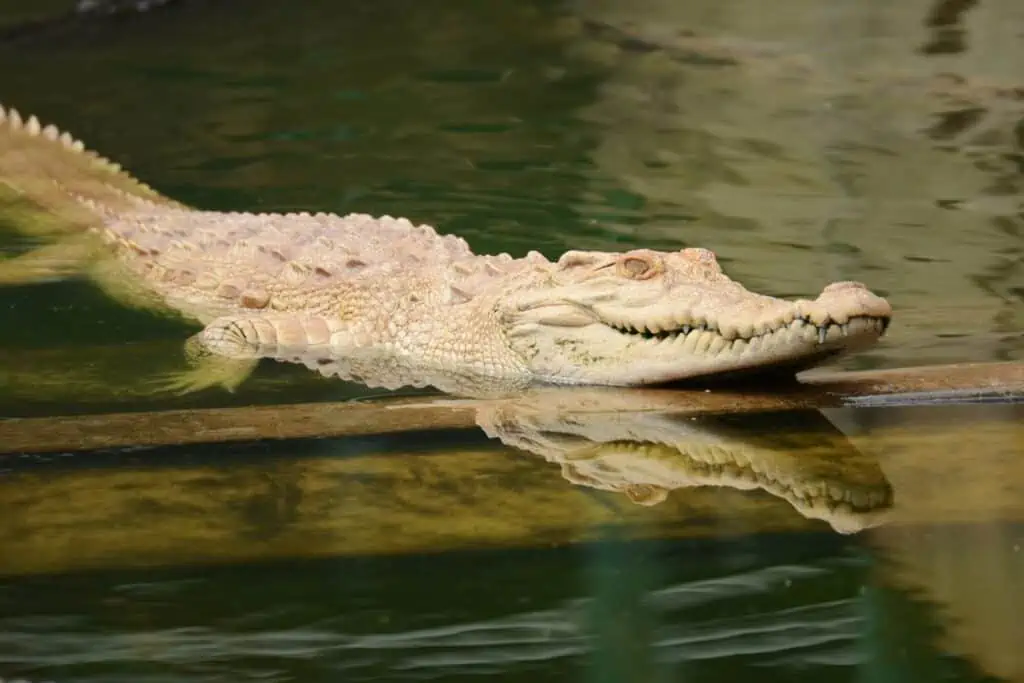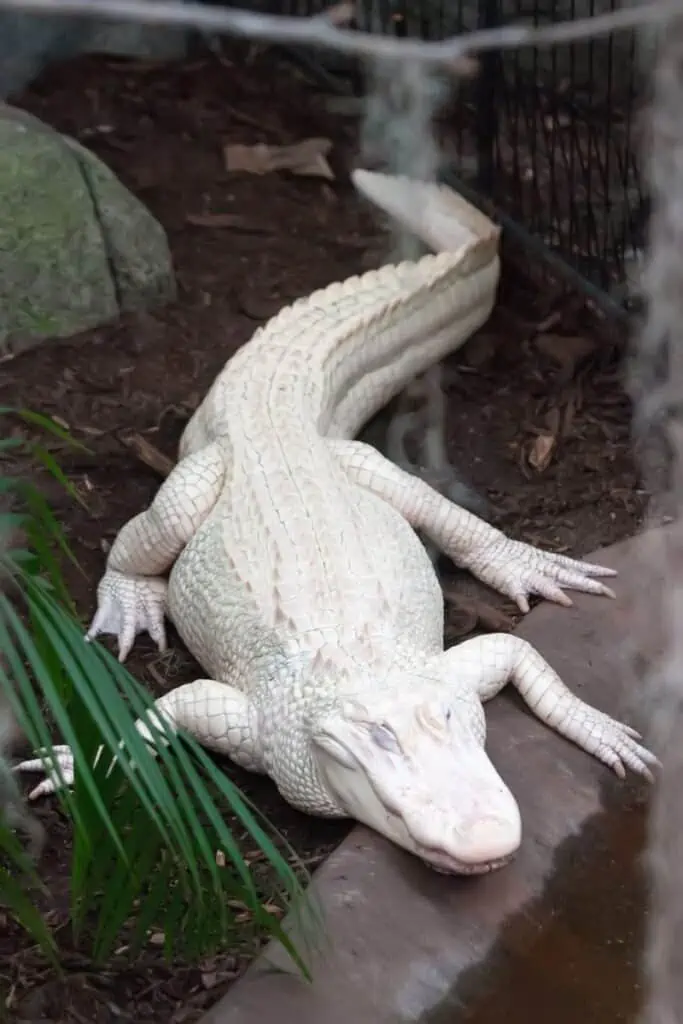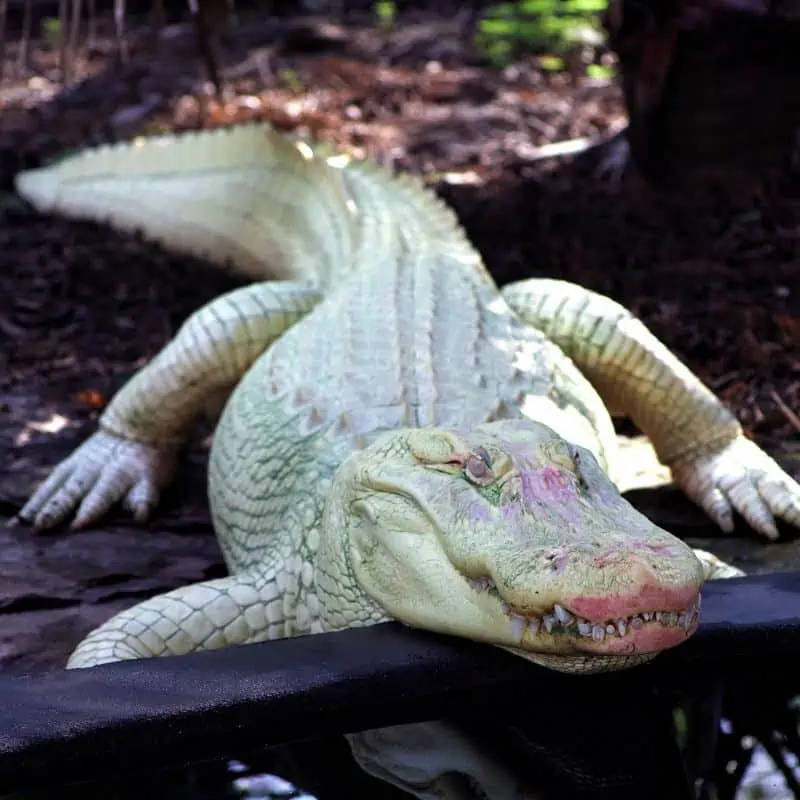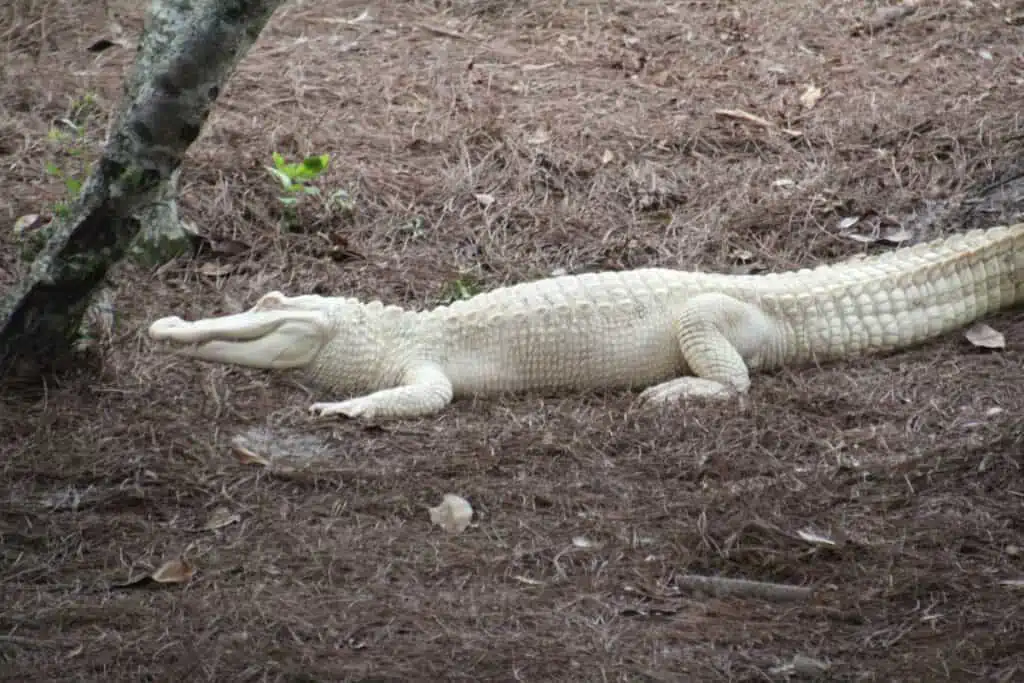An albino crocodile and an albino alligator is an extremely rare sight. They are born with a genetic disorder that prevents the production of melanin – the pigment that gives color to the skin and eyes.
Due to a lack of pigmentation, albino crocodiles and alligators display yellowish-white hues across their bodies. So let us look at some facts about these beautiful and rare creatures.
Facts About Albino Crocodiles And Alligators:
- Albinos cannot create melanin
- People hunt albinos
- Albino crocodiles and alligators are extremely rare
- Albinos are at risk from predators
- Albinism is inherited
- Being an albino does not necessarily make them blind
- Two albinos at Augustine Alligator Farm Zoological Park
- Albino crocodiles can live a long life
- Sun damages their skin
- The oldest recorded albino alligator is 27
- Leucistic and albino alligators are different
- Crocs and alligators are protected
- Seeing one is good luck
- Albinism does not affect diet
- They’re safer in captivity
Let’s look at each of these points in more detail.

- 1. Albinos Cannot Create Melanin
- 2. People Hunt Albino Crocodiles And Alligators
- 3. Albino Crocodiles And Alligators Are Extremely Rare
- 4. Albinos Are At Higher Risk From Predators
- 5. Albinism Is Inherited
- 6. Being An Albino Does Not Necessarily Make Them Blind
- 7. Two Albinos At Augustine Alligator Farm Zoological Park
- 8. Albino Crocodiles Can Live A Long Life
- 9. Sun Damages Their Skin
- 10. The Oldest Recorded Albino Alligator Is 27 Years Old
- 11. There Is A Difference Between A Leucistic And Albino Alligator
- 12. Alligators And Crocodiles Are Protected Under the Act (ESA) Of 1973
- 13. It’s Good Luck To See One
- 14. Albinism Does Not Affect An Alligator’s Or Crocodile’s Diet
- 15. It’s Safer For Them To Be Kept In Captivity
- Final Thoughts On Albino Alligators And Crocodiles
1. Albinos Cannot Create Melanin
Albino crocodiles/alligators cannot create melanin, so their skin and eyes are unpigmented.
This unpigmented skin makes them look white.
2. People Hunt Albino Crocodiles And Alligators
Albino crocodiles and alligators are rare. The absence of color makes this species appealing to hunters who seek wealth and good fortune by selling their skins.
People then use the crocodile or alligator’s skin to make purses, boots, jackets, belts, and wallets.
Like all crocodiles and alligators, people also hunt albinos for meat. In Asia and the Southern United States, many people eat crocodile meat, especially those who live in poverty and near crocodiles.
3. Albino Crocodiles And Alligators Are Extremely Rare
As mentioned before, albino alligators are extremely rare.
There are only approximately 100 albino alligators globally.
Albino crocodiles are even rarer, with no number being recorded.
4. Albinos Are At Higher Risk From Predators
The fact that albino crocodiles and alligators don’t have any pigmentation gives them white skin and eyes and no camouflage in the wild.
This puts albino crocodiles at severe risk if they live in the wild since they don’t stand a chance against predators.

5. Albinism Is Inherited
If a crocodile carries the gene, it can pass albinism down to its offspring.
However, the gene is recessive, so both parents need to have it to pass it down to their offspring. This is what makes it so rare.
6. Being An Albino Does Not Necessarily Make Them Blind
Some people believe that being an albino makes them blind, but this is not true for alligators and crocodiles.
Albinos have more sensitive eyes than non-albinos, but this heightened sensitivity does not necessarily compromise the organ’s function.
7. Two Albinos At Augustine Alligator Farm Zoological Park
Snowflake, 23 years old, and Blizzard, 12 years old, are two albino alligators living at the Augustine Alligator Farm Zoological Park in Florida
The farm takes great care in monitoring these two alligators’ enclosure — no matter the climate of the gator park.
They pay incredibly close attention to ensuring albino alligators are warm while also keeping them out of direct sunlight.
Blizzard and Snowflake’s favorite food is chicken, and they dive for treats thrown to the bottom of their pool.
8. Albino Crocodiles Can Live A Long Life
Albinism does not necessarily shorten an alligator or crocodile’s life span.
They can live as long as other crocodiles and alligators. Some alligators can live as long as 80 years old.
9. Sun Damages Their Skin
While they may look exotic and beautiful, albinism comes at a price. The sun can damage their skin when albino alligators and crocodiles are in the sun for long periods.
Albino crocodiles and alligators are usually kept in a special enclosure that’s warm but away from direct sunlight in zoos, parks, and aquariums.
As a result, even their eyes can get burnt, which may severely impact their vision.

10. The Oldest Recorded Albino Alligator Is 27 Years Old
On 15 September 1995, an albino alligator named Claude was born in Louisiana.
He currently lives at the California Academy of Sciences in San Francisco, weighs 222 pounds, is 9 feet 5 inches long, and has 76 teeth.
He is 27 years old. Albinism prevented him from camouflaging into his surroundings like other alligators, making him vulnerable in the wilderness.
In 2008, Claude was brought to the California Academy of Sciences. The following year, the infection resulted in the amputation of one of the fingers on Claude’s right claw after another alligator bit him.
11. There Is A Difference Between A Leucistic And Albino Alligator
There are two types of white alligators and crocodiles: leucistic and albino crocodiles and alligators.
Albinism is a congenital disability. The absence of melanin gives skin, hair, and eyes color. However, other animals with different pigment cells are not pure white but have a light-yellow tint.
Animals with leucism have partial loss of pigmentation, resulting in white, patched, or incompletely colored areas.
Partial leucism, also called the “pied” or “piebald” effect, results in white patches on an animal’s skin that lack pigment and are irregular in shape.
The primary purpose of melanin, a pigment, is to protect against ultraviolet rays, which can cause skin cancer or malignant tumors.
The melanin in our skin absorbs harmful energy from the sun’s rays and disperses it as heat.
Albino animals can be distinguished from leucistic animals by their eye color. Albino animal eyes are pink or red, while leucistic animal eyes are brown or black.
This is because the lack of melanin in crocodiles and alligators with albinism results in red eyes, as the underlying blood vessels are visible through the iris.
Leucism does not affect their vision or the color of their eyes. Unfortunately, their eyesight is not as sharp, and they cannot see fine details.
12. Alligators And Crocodiles Are Protected Under the Act (ESA) Of 1973
The ESA of 1973 protects all species of alligators and crocodiles that are endangered or threatened.
This includes crocodiles with albinism. Many of these species are found in Florida and Louisiana, but some can be found in other parts of the country.
Albino alligators and crocodiles are extremely rare.
13. It’s Good Luck To See One
It is widely believed in folklore that seeing a white crocodile or alligator brings good luck and fortune.
This is why hunters and locals often hunt them down in hopes of bringing good luck to themselves or others.
14. Albinism Does Not Affect An Alligator’s Or Crocodile’s Diet
Albino crocodiles and alligators can eat their usual diet without altering it. They don’t have any special dietary requirements due to their condition.
In addition, there’s no scientific evidence that the color of an animal affects its health.
15. It’s Safer For Them To Be Kept In Captivity

Albino crocodiles and alligators are very vulnerable. Though they hatch with the ability to evade their natural predators for a short time, their light color makes them easy targets.
As a result, albino crocodiles and alligators are more likely to survive when kept in captivity.
In addition, because they are sensitive to sunlight, they must be housed in special enclosures that block the sun’s ultraviolet rays.
Of the adult American alligator population, which consists of more than 1 million alligators, it is estimated that there are less than 100 albinos and only approximately 12 leucistic alligators.
Some of the older alligators are over ten feet long and can weigh up to 800 pounds.
People discovered them as infants in Louisiana swamps and Florida’s Everglades. Alligator farms, zoos, and theme parks are all places where you can see them.
Leucistic crocodiles are incredibly rare, with only 1 in 10,000 hatchlings displaying the condition.
Albino crocodiles are even more scarce – people rarely get to see them in the wild.
Albino or leucistic crocodiles and alligators, who lack the usual dark coloration, share the same physical attributes as their more common counterparts.
Final Thoughts On Albino Alligators And Crocodiles
Albino crocodiles and alligators are extremely rare and have been hunted for their skin.
These animals cannot create melanin, which makes them sensitive to the sun. As a result, they can’t bask in the sun as long as their non-albino cousins.
Because they are so rare, it is considered good luck to see one in the wild.
Although their diet is unaffected by their albinism, these animals face many challenges due to their unique appearance.
We hope this article has helped shed some light on these rare reptiles.
